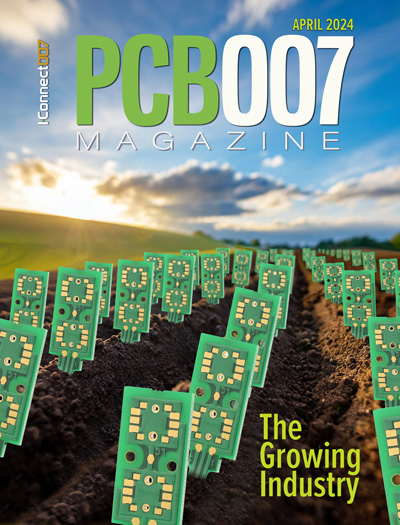-

- News
- Books
Featured Books
- pcb007 Magazine
Latest Issues
Current Issue
The Growing Industry
In this issue of PCB007 Magazine, we talk with leading economic experts, advocacy specialists in Washington, D.C., and PCB company leadership to get a well-rounded picture of what’s happening in the industry today. Don’t miss it.

The Sustainability Issue
Sustainability is one of the most widely used terms in business today, especially for electronics and manufacturing but what does it mean to you? We explore the environmental, business, and economic impacts.

The Fabricator’s Guide to IPC APEX EXPO
This issue previews many of the important events taking place at this year's show and highlights some changes and opportunities. So, buckle up. We are counting down to IPC APEX EXPO 2024.
- Articles
- Columns
Search Console
- Links
- Events
||| MENU - pcb007 Magazine
Plating and Quality are Close Partners
August 19, 2015 | Bob TarzwellEstimated reading time: 1 minute
Something that I frequently hear these days is that we are losing the older, seasoned, well-trained people in the PCB business—people who really know how to manage and keep a plating area producing high-quality product. The entire process of plating from end to end, with all its subtle nuances and time-learned tricks, is not something you can just pick up in a few years.
A good plating manager is a seasoned veteran with many years of hands-on experience and probably an engineering degree. I also see firsthand how PCB manufacturers, without the proper plating shop set-up operations, knowledge and experience, adapt and accept poor practices as normal while they continue with poor quality processes—even after attempted corrective input from vendors and consultants. These same companies accept their yields at 70%, while unnecessarily losing millions each year, and just accept it as part of doing business. Yet when told of other manufacturers who are routinely above 98% first-pass yield, they argue with you, find 100 reasons why you’re wrong, and do nothing about their own situation.
So I’ve documented a few of the bigger mistakes I see PCB shops making in the hope of educating readers and changing the way they look at the plating process as a built-in quality requirement, rather than just a dirty, stinky old line that plates copper.
First, if you need rubber boots to walk in your plating area, then it’s time to clean it up; good plating areas are clean, well-lit, low-dust areas that have well thought out ventilation. A dirty plating area is hard on quality, because you are fighting contamination and dirt; both have potentially big effects on plating. If your copper tanks sit uncovered and there is dust in the air from either a routing operation that’s too close or open doors to the great outdoors, the dust will settle into the tank and give you plating bumps. I have seen plating areas where all boards had to be sanded flat because the copper bumps were so frequent and large. Typically we sort out the problem by finding the dust source, correcting it, super-cleaning the tanks, and adding new solution.
This article originally appeared in the August 2015 issue of The PCB Magazine.
Suggested Items
Designer’s Notebook: What Designers Need to Know About Manufacturing, Part 2
04/24/2024 | Vern Solberg -- Column: Designer's NotebookThe printed circuit board (PCB) is the primary base element for providing the interconnect platform for mounting and electrically joining electronic components. When assessing PCB design complexity, first consider the component area and board area ratio. If the surface area for the component interface is restricted, it may justify adopting multilayer or multilayer sequential buildup (SBU) PCB fabrication to enable a more efficient sub-surface circuit interconnect.
Insulectro’s 'Storekeepers' Extend Their Welcome to Technology Village at IPC APEX EXPO
04/03/2024 | InsulectroInsulectro, the largest distributor of materials for use in the manufacture of PCBs and printed electronics, welcomes attendees to its TECHNOLOGY VILLAGE during this year’s IPC APEX EXPO at the Anaheim Convention Center, April 9-11, 2024.
ENNOVI Introduces a New Flexible Circuit Production Process for Low Voltage Connectivity in EV Battery Cell Contacting Systems
04/03/2024 | PRNewswireENNOVI, a mobility electrification solutions partner, introduces a more advanced and sustainable way of producing flexible circuits for low voltage signals in electric vehicle (EV) battery cell contacting systems.
Heavy Copper PCBs: Bridging the Gap Between Design and Fabrication, Part 1
04/01/2024 | Yash Sutariya, Saturn Electronics ServicesThey call me Sparky. This is due to my talent for getting shocked by a variety of voltages and because I cannot seem to keep my hands out of power control cabinets. While I do not have the time to throw the knife switch to the off position, that doesn’t stop me from sticking screwdrivers into the fuse boxes. In all honesty, I’m lucky to be alive. Fortunately, I also have a talent for building high-voltage heavy copper circuit boards. Since this is where I spend most of my time, I can guide you through some potential design for manufacturability (DFM) hazards you may encounter with heavy copper design.
Trouble in Your Tank: Supporting IC Substrates and Advanced Packaging, Part 5
03/19/2024 | Michael Carano -- Column: Trouble in Your TankDirect metallization systems based on conductive graphite or carbon dispersion are quickly gaining acceptance worldwide. Indeed, the environmental and productivity gains one can achieve with these processes are outstanding. In today’s highly competitive and litigious environment, direct metallization reduces costs associated with compliance, waste treatment, and legal issues related to chemical exposure. What makes these processes leaders in the direct metallization space?


